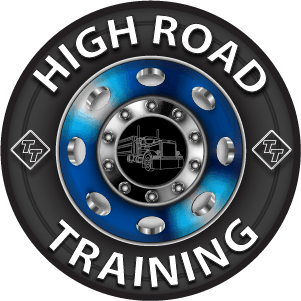Note: Your are not logged in. We can not keep your scores or track your progress unless you Register and Log In
2.7.6 – Space for Turns
The space around a truck or bus is important in turns. Because of wide turning and off-tracking, large vehicles can hit other vehicles or objects during turns.
Right Turns
Following are some rules to help prevent right-turn crashes:
- Turn slowly to give yourself and others more time to avoid problems.
- If you are driving a truck or bus that cannot make the right turn without swinging into another lane, turn wide as you complete the turn. Keep the rear of your vehicle close to the curb. This will stop other drivers from passing you on the right.
- Do not turn wide to the left as you start the turn. A following driver may think you are turning left and try to pass you on the right. You may crash into the other vehicle as you complete your turn.
- If you must cross into the oncoming lane to make a turn, watch out for vehicles coming toward you. Give them room to go by or to stop. However, do not back up for them because you might hit someone behind you.
Left Turns
- On a left turn, make sure you have reached the center of the intersection before you start the left turn. If you turn too soon, the left side of your vehicle may hit another vehicle because of off-tracking.
- If there are two lefthand turning lanes, always take the one on the right. Do not start in the inside lane because you may have to swing right to make the turn. Drivers on your left can be more readily seen.
2.7.7 – Space Needed to Cross or Enter Traffic
Be aware of the size and weight of your vehicle when you cross or enter traffic. Here are some important things to keep in mind:
- Because of slow acceleration and the space large vehicles require, you may need a much larger gap to enter traffic than you would in a car.
- Acceleration varies with the load. Allow more room if your vehicle is heavily loaded.
- Before you start across a road, make sure you can get all the way across before traffic reaches you.
Multiple-Choice Questions:
When making a right turn, you should not turn wide to the left as you start the turn. Why not?
- People on the road you're turning onto can not see you as well if you swing to the left first.
- You won't have as much room to make the turn if you swing out to the left before the turn.
- A following driver may think you are turning left and try to pass you on the right. You may crash into the other vehicle as you complete your turn.
- It is against the law to swing wide to the left before making a right-hand turn
If you are driving a truck or bus that cannot make the right turn without swinging into another lane, turn wide as you complete the turn. Keep the rear of your vehicle close to the curb. This will stop other drivers from passing you on the right.
Do not turn wide to the left as you start the turn. A following driver may think you are turning left and try to pass you on the right. You may crash into the other vehicle as you complete your turn.
In practice, you will often swing to the left before making a right-hand turn because you won't have enough room to make the turn otherwise. You must be especially careful to watch that passenger-side mirror to make sure no one came alongside you when you made the swing.
In trucking, sometimes you gotta do what ya gotta do to make it happen.
If there are two left turning lanes, which one should you use, and why?
- Always take the one on the left. You want any cars on your right side when you're making a lefthand turn.
- Always take the one on the right. Do not start in the inside lane because you may have to swing right to make the turn. Drivers on your left can be more readily seen.
- Always take the one on the left. If you happen to run over the curb to your left during the turn, well that's a better option than running over a car.
- Always take the one on the right. If you need to cut left during the turn to block traffic momentarily, you can do so more easily from the lane on the right.
Complete!
You can Return To The Table Of Contents







 TT On Facebook
TT On Facebook